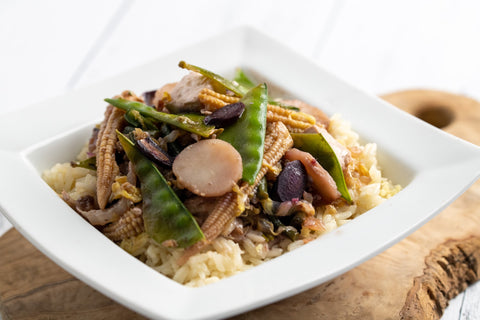Buddha’s Feast

This year’s Chinese New Year, also known as Lunar New Year, began on January 22 and runs for 16 days through February 8. It’s the year of the rabbit, and everyone knows how much bunnies love their veggies. Buddha’s Feast or Buddha’s Delight is the perfect recipe to represent this year’s celebration.
Buddha’s Feast is traditionally served at the beginning of the holiday period, based on the Buddhist’s belief that maintaining a vegetarian diet is a form of self-purification to begin the New Year. Chinese Master Chef Martin Yan (of Yan Can Cook fame) wrote in his book “Culinary Journey Through China”:
“Vegetarian cooking was introduced to China in the kitchens of Buddhist and Taoist monasteries more than 2,000 years ago. The practice of abstaining from eating meat was originally tied to a belief in reincarnation. Over the centuries, Chinese vegetarian cooking has developed into a sophisticated cuisine in its own right.”
Particularly popular in Southern China, where produce is plentiful, Buddha’s Feast is usually made with various vegetables and other vegetarian ingredients (e.g., tofu) cooked in a flavorful brown sauce until tender. Because the Buddhist diet typically prohibits the use of ingredients in the garlic and onion family, the dish gets its flavors from the freshly cooked vegetables themselves, along with the soy sauce, ginger, sesame oil, white pepper, the vegetarian oyster or hoisin sauce, and the concentrated umami from the mushrooms.
Authentic, easy, hearty and substantial, much like a Chinese vegetarian stew, this restaurant-quality Buddha’s Feast is truly a delight.
Ingredients

For the sauce:
1 cup vegetable broth
2 ½ tablespoons soy sauce
2 ½ tablespoons hoisin or vegetarian oyster sauce
3 teaspoons sesame oil
1 teaspoon white pepper
Salt to taste
For the veggies:
2 tablespoons vegetable oil
1 package Dried Oyster Mushrooms, rehydrated, drained and diced
1 tablespoon ginger, minced
1 cup baby purple or organic carrots, sliced
1 cup sno peas, cut in half
1 cup Chinese long beans, cut into 1 ½ “pieces
1 package Extra Firm Tofu, cut into 1” cubes
½ can baby corn, cut in half
½ tub Melissa’s Sliced Waterchestnuts
2 cups Napa cabbage, chopped
2 teaspoons cornstarch dissolved in 1 tablespoon of water
Directions

Combine the sauce ingredients in a bowl. Whisk to combine and set aside.

Place a sauté pan or wok over high heat. Add the vegetable oil and swirl to coat the sides of the pan. Add the ginger and mushrooms and sauté about 20-30 seconds until fragrant.

Add in the carrots, sno peas and long beans and stir fry for 3 minutes.

Add in the tofu, corn and water chestnuts and stir fry for another 2 minutes.

Add the Napa cabbage and the sauce and simmer until the vegetables are tender, about 3-4 minutes. Add in the cornstarch/water mixture, stir to combine, and cook until the sauce thickens. Adjust seasonings if desired.

Serve over brown or white rice.

